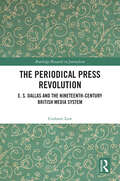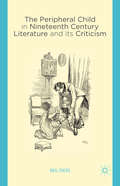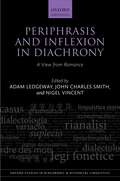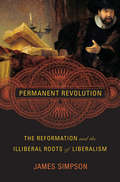- Table View
- List View
Performing women: Gender, self, and representation in late medieval Metz (Manchester Medieval Literature and Culture)
by Susannah CrowderThis book takes on a key problem in the history of drama: the ‘exceptional’ staging of the life of Catherine of Siena by a female actor and a female patron in 1468 Metz. Exploring the lives and performances of these previously anonymous women, the book brings the elusive figure of the female performer to centre stage. It integrates new approaches to drama, gender and patronage with a performance methodology to explore how the women of fifteenth-century Metz enacted varied kinds of performance that extended beyond the theatre. For example, decades before the 1468 play, Joan of Arc returned from the grave in the form of an impersonator named Claude. Offering a new paradigm of female performance that positions women at the core of public culture, Performing women is essential reading for scholars of pre-modern women and drama, and is also relevant to lecturers and students of late-medieval performance, religion and memory.
Performing women: Gender, self, and representation in late medieval Metz (Manchester Medieval Literature and Culture)
by Susannah CrowderThis book takes on a key problem in the history of drama: the ‘exceptional’ staging of the life of Catherine of Siena by a female actor and a female patron in 1468 Metz. Exploring the lives and performances of these previously anonymous women, the book brings the elusive figure of the female performer to centre stage. It integrates new approaches to drama, gender and patronage with a performance methodology to explore how the women of fifteenth-century Metz enacted varied kinds of performance that extended beyond the theatre. For example, decades before the 1468 play, Joan of Arc returned from the grave in the form of an impersonator named Claude. Offering a new paradigm of female performance that positions women at the core of public culture, Performing women is essential reading for scholars of pre-modern women and drama, and is also relevant to lecturers and students of late-medieval performance, religion and memory.
Performing Women: Stand-ups, Strumpets and Itinerants
by Alison OddeyAlison Oddey's interviews with prominent performing women span generations, cultures, perspectives, practice and the best part of the twentieth century, telling various stories collectively. Stand-ups, 'classic' actresses, film and television personalities, experimental and 'alternative' practitioners discuss why they want to perform, what motivates them, and how their personal history has contributed to their desires to perform. Oddey's critical introductory and concluding chapters analyse both historical and cultural contexts and explore themes arising from interviews. These include sense of identity, acting as playing (recapturing and revisiting childhood), displacement of roots, performing, motherhood and 'being', performing comedy, differences between theatre, film and television performance, attitudes towards and relationships with audiences, and working with directors. The prominent subtext of motherhood reveals a consciousness of split subjectivities with and beyond performance.
Performing Women: Stand-Ups, Strumpets and Itinerants
by Alison OddeyAlison Oddey's interviews with prominent performing women span generations, cultures, perspectives, practice and the best part of the twentieth-century, telling various stories collectively. Stand-ups, 'classic' actresses, film and television personalities, experimental and 'alternative' practitioners discuss why they want to perform, what motivates them, and how their personal history has contributed to their desire to perform. Oddey's critical introductory and concluding chapters analyze both historical and cultural contexts and explore themes arising from the interviews. These include sense of identity, acting as playing (recapturing and revisiting childhood), displacement of roots, performing, motherhood and 'being', performing comedy, differences between theatre, film and television performance, attitudes towards and relationships with audiences, and working with directors. The prominent subtext of motherhood reveals a consciousness of split subjectives with and beyond performance. This new edition of the book includes three new interviews with actresses, and is useful primary resource material for undergraduate students on performance studies courses.
Perfume (Object Lessons)
by Megan VolpertObject Lessons is a series of short, beautifully designed books about the hidden lives of ordinary things.Our sense of smell is crucial to our survival. We can smell fear, disease, food. Fragrance is also entertainment. We can smell an expensive bottle of perfume at a high-end department store. Perhaps it reminds us of our favorite aunt. A memory in a bottle is a powerful thing. Megan Volpert's Perfume carefully balances the artistry with the science of perfume. The science takes us into the neurology of scent receptors, how taste is mostly smell, the biology of illnesses that impact scent sense, and the chemistry of making and copying perfume. The artistry of perfume involves the five scent families and symbolism, subjectivity in perfume preference, perfume marketing strategies, iconic scents and perfumers, why the industry is so secretive, and Volpert's own experiments with making perfume. Object Lessons is published in partnership with an essay series in The Atlantic.
Perfume (Object Lessons)
by Megan VolpertObject Lessons is a series of short, beautifully designed books about the hidden lives of ordinary things.Our sense of smell is crucial to our survival. We can smell fear, disease, food. Fragrance is also entertainment. We can smell an expensive bottle of perfume at a high-end department store. Perhaps it reminds us of our favorite aunt. A memory in a bottle is a powerful thing. Megan Volpert's Perfume carefully balances the artistry with the science of perfume. The science takes us into the neurology of scent receptors, how taste is mostly smell, the biology of illnesses that impact scent sense, and the chemistry of making and copying perfume. The artistry of perfume involves the five scent families and symbolism, subjectivity in perfume preference, perfume marketing strategies, iconic scents and perfumers, why the industry is so secretive, and Volpert's own experiments with making perfume. Object Lessons is published in partnership with an essay series in The Atlantic.
Perilous Passages: The Book of Margery Kempe, 1534–1934 (The New Middle Ages)
by Julie ChappellThis study will significantly further our interpretations of the unique autobiography of Margery Kempe, lay woman turned mystic and visionary. Following the manuscript from a Carthusian monastery through history, Chappell bridges the gaps in our understanding of the transmission of texts from the medieval past to the present.
The Perils of Print Culture: Book, Print and Publishing History in Theory and Practice (New Directions in Book History)
by Jason McElligottThis collection of essays illustrates various pressures and concerns—both practical and theoretical—related to the study of print culture. Procedural difficulties range from doubts about the reliability of digitized resources to concerns with the limiting parameters of 'national' book history.
Perils of the Night: A Feminist Study of Nineteenth-Century Gothic
by Eugenia C. DeLamotteThis book argues that the source of Gothic terror is anxiety about the boundaries of the self: a double fear of separateness and unity that has had a special significance for women writers and readers. Exploring the psychological, religious, and epistemological context of this anxiety, DeLamotte argues that the Gothic vision focuses simultaneously on the private demons of the psyche and the social realities that helped to shape them. Her analysis includes works of English and American authors, among them Henry James, Mary Shelley, Herman Melville, Nathaniel Hawthorne, Emily Brontë, Charlotte Brontë, and a number of often neglected popular women Gothicists.
The Periodical Press in Nineteenth-Century Ireland (New Directions in Book History)
by Elizabeth TilleyThis book offers a new interpretation of the place of periodicals in nineteenth-century Ireland. Case studies of representative titles as well as maps and visual material (lithographs, wood engravings, title-pages) illustrate a thriving industry, encouraged, rather than defeated by the political and social upheaval of the century. Titles examined include: The Irish Magazine, and Monthly Asylum for Neglected Biography and The Irish Farmers’ Journal, and Weekly Intelligencer; The Dublin University Magazine; Royal Irish Academy Transactions and Proceedings and The Dublin Penny Journal; The Irish Builder (1859-1979); domestic titles from the publishing firm of James Duffy; Pat and To-Day’s Woman. The Appendix consists of excerpts from a series entitled ‘The Rise and Progress of Printing and Publishing in Ireland’ that appeared in The Irish Builder from July of 1877 to June of 1878. Written in a highly entertaining, anecdotal style, the series provides contemporary information about the Irish publishing industry.
The Periodical Press Revolution: E. S. Dallas and the Nineteenth-Century British Media System (Routledge Research in Journalism)
by Graham LawThis book explores a key aspect of journalism history from a sociological perspective: the rise of the periodical press. With a focus not on the economic and technological causes of this revolution but on the social and political consequences, the book takes a global look at this key development in the British press.Taking as a point of departure the theory of E.S. Dallas, who defined the periodical as 'the great event in modern history', the book explores these premises and conclusions regarding authorship, publishing, and readership, considering the nineteenth century as a whole. After an introductory section discussing questions of theory and method, the analysis first offers an overview of the quantitative growth of the periodical market, whether measured in terms of publications, readership, or authorship, before turning to a more detailed consideration of its qualitative determinants and effects, again distinguishing the same three aspects.Offering new insight into this key turning point in journalism history, this book will be of interest to all students and scholars of journalism and journalism history, media history, media and communication studies, British history, and modern history.
The Periodical Press Revolution: E. S. Dallas and the Nineteenth-Century British Media System (Routledge Research in Journalism)
by Graham LawThis book explores a key aspect of journalism history from a sociological perspective: the rise of the periodical press. With a focus not on the economic and technological causes of this revolution but on the social and political consequences, the book takes a global look at this key development in the British press.Taking as a point of departure the theory of E.S. Dallas, who defined the periodical as 'the great event in modern history', the book explores these premises and conclusions regarding authorship, publishing, and readership, considering the nineteenth century as a whole. After an introductory section discussing questions of theory and method, the analysis first offers an overview of the quantitative growth of the periodical market, whether measured in terms of publications, readership, or authorship, before turning to a more detailed consideration of its qualitative determinants and effects, again distinguishing the same three aspects.Offering new insight into this key turning point in journalism history, this book will be of interest to all students and scholars of journalism and journalism history, media history, media and communication studies, British history, and modern history.
Peripheral Actors in Journalism: Deviating from the Norm? (Routledge Focus on Journalism Studies)
by Aljosha Karim SchapalsThis book addresses the transformative role that so-called peripheral actors in journalism – emerging outlets diverging from the norms fiercely held by mainstream media outlets – play in today’s news ecosystem. The author charts the rise to prominence of these actors, outlining how they have successfully managed to challenge the authority held by mainstream, legacy outlets, whose claims to be the “storytellers of our time” no longer exclusively pertain to them. Beginning by identifying these peripheral actors specifically, the book then considers whether what they do is “journalism” as traditionally conceived, what their motivations are, and why their role is important in light of journalism’s democratic function in holding power to account. Ultimately, it is argued that, despite the perceived role of peripheral actors as “deviant”, they still demonstrate a surprising degree of ideological continuity in the face of industrial disruption. Drawing on research from Australia, Germany, and the United Kingdom, Peripheral Actors in Journalism is an insightful resource for journalism and media scholars with an interest in alternative media sources.
Peripheral Actors in Journalism: Deviating from the Norm? (Routledge Focus on Journalism Studies)
by Aljosha Karim SchapalsThis book addresses the transformative role that so-called peripheral actors in journalism – emerging outlets diverging from the norms fiercely held by mainstream media outlets – play in today’s news ecosystem. The author charts the rise to prominence of these actors, outlining how they have successfully managed to challenge the authority held by mainstream, legacy outlets, whose claims to be the “storytellers of our time” no longer exclusively pertain to them. Beginning by identifying these peripheral actors specifically, the book then considers whether what they do is “journalism” as traditionally conceived, what their motivations are, and why their role is important in light of journalism’s democratic function in holding power to account. Ultimately, it is argued that, despite the perceived role of peripheral actors as “deviant”, they still demonstrate a surprising degree of ideological continuity in the face of industrial disruption. Drawing on research from Australia, Germany, and the United Kingdom, Peripheral Actors in Journalism is an insightful resource for journalism and media scholars with an interest in alternative media sources.
The Peripheral Child in Nineteenth Century Literature and its Criticism
by N. CocksEstablished accounts of the child in nineteenth century literature tend to focus on those who occupy a central position within narratives. This book is concerned with children who are not so easily recognized or remembered, the peripheral or overlooked children to be read in works by Dickens, Brontë, Austen and Rossetti.
Peripheral Visions for Writing Centers
by Jackie Grutsch McKinneyPeripheral Visions for Writing Centers aims to inspire a re-conception and re-envisioning of the boundaries of writing center work. Moving beyond the grand narrative of the writing center—that it is solely a comfortable, yet iconoclastic place where all students go to get one-to-one tutoring on their writing—McKinney shines light on other representations of writing center work. McKinney argues that this grand narrative neglects the extent to which writing center work is theoretically and pedagogically complex, with ever-changing work and conditions, and results in a straitjacket for writing center scholars, practitioners, students, and outsiders alike. Peripheral Visions for Writing Centers makes the case for a broader narrative of writing center work that recognizes and theorizes the various spaces of writing center labor, allows for professionalization of administrators, and sees tutoring as just one way to perform writing center work. McKinney explores possibilities that lie outside the grand narrative, allowing scholars and practitioners to open the field to a fuller, richer, and more realistic representation of their material labor and intellectual work.
Peripheral Visions / Global Sounds: From Galicia to the World (Contemporary Hispanic and Lusophone Cultures #16)
by José ColmeiroGalician audio/visual culture has experienced an unprecedented period of growth following the process of political and cultural devolution in post-Franco Spain. This creative explosion has occurred in a productive dialogue with global currents and with considerable projection beyond the geopolitical boundaries of the nation and the state, but these seismic changes are only beginning to be the subject of attention of cultural and media studies. This book examines contemporary audio/visual production in Galicia as privileged channels through which modern Galician cultural identities have been imagined, constructed and consumed, both at home and abroad. The cultural redefinition of Galicia in the global age is explored through different media texts (popular music, cinema, video) which cross established boundaries and deterritorialise new border zones where tradition and modernity dissolve, generating creative tensions between the urban and the rural, the local and the global, the real and the imagined. The book aims for the deperipheralization and deterritorialization of the Galician cultural map by overcoming long-established hegemonic exclusions, whether based on language, discipline, genre, gender, origins, or territorial demarcation, while aiming to disjoint the center/periphery dichotomy that has relegated Galician culture to the margins. In essence, it is an attempt to resituate Galicia and Galician studies out of the periphery and open them to the world.
Peripheralizing DeLillo: Surplus Populations, Capitalist Crisis, and the Novel
by Thomas TraversPeripheralizing DeLillo tracks the historical arc of Don DeLillo's poetics as it recomposes itself across the genres of short fiction, romance, the historical novel, and the philosophical novel of time. Drawing on theories that capital, rather than the bourgeoisie, is the displaced subject of the novel, Thomas Travers investigates DeLillo's representation of fully commodified social worlds and re-evaluates Marxist accounts of the novel and its philosophy of history. Deploying an innovative re-periodisation, Travers considers the evolution of DeLillo's aesthetic forms as they register and encode one of the crises of contemporary historicity: the secular dynamics through which a society organised around waged work tends towards conditions of under- and unemployment. Situating DeLillo within global histories of uneven and combined development, Travers explores how DeLillo's treatment of capital and labour, affect and narration, reconfigures debates around realism and modernism. The DeLillo that emerges from this study is no longer an exemplary postmodern writer, but a composer of capitalist epics, a novelist drawn to peripheral zones of accumulation, zones of social death whose surplus populations his fiction strives to re-historicise, if not re-dialecticise as subjects of history.
Peripheralizing DeLillo: Surplus Populations, Capitalist Crisis, and the Novel
by Thomas TraversPeripheralizing DeLillo tracks the historical arc of Don DeLillo's poetics as it recomposes itself across the genres of short fiction, romance, the historical novel, and the philosophical novel of time. Drawing on theories that capital, rather than the bourgeoisie, is the displaced subject of the novel, Thomas Travers investigates DeLillo's representation of fully commodified social worlds and re-evaluates Marxist accounts of the novel and its philosophy of history. Deploying an innovative re-periodisation, Travers considers the evolution of DeLillo's aesthetic forms as they register and encode one of the crises of contemporary historicity: the secular dynamics through which a society organised around waged work tends towards conditions of under- and unemployment. Situating DeLillo within global histories of uneven and combined development, Travers explores how DeLillo's treatment of capital and labour, affect and narration, reconfigures debates around realism and modernism. The DeLillo that emerges from this study is no longer an exemplary postmodern writer, but a composer of capitalist epics, a novelist drawn to peripheral zones of accumulation, zones of social death whose surplus populations his fiction strives to re-historicise, if not re-dialecticise as subjects of history.
Peripheries: Syntactic Edges and their Effects (Studies in Natural Language and Linguistic Theory #59)
by David Adger George Tsoulas Cécile De CatThe syntactic periphery has become one of the most important areas of research in syntactic theory in recent years, due to the emergence of new research programmes initiated by Rizzi, Kayne and Chomsky. However research has concentrated on the empirical nature of clausal peripheries. The purpose of this volume is to explore the question of whether the notion of periphery has any real theoretical bite. An important consensus emerging from the volume is that the edges of certain syntactic expressions appear to be the locus of the connection between phrase structure, prosody, and information structure. This volume contains 16 papers by researchers in this area. The book: - contains an extensive introduction setting out the research questions addressed and setting the contributions in an overall theoretical context, - has a distinct comparative slant, - brings together work from a range of theoretical perspectives, while maintaining a unity of purpose, - could serve as the basis for a graduate course on peripheral positions, - contains papers addressing: = the question of the fine-grainedness of syntactic representations, = the relevance of syntactic edges to locality and semantic interpretation, = the nature of the dependencies connecting peripheral elements to the syntactic core. Audience: Academics and graduate students interested in syntax and its interfaces with semantics and prosody, acquisition of syntax, cross-linguistic comparison.
Periphrasis and Inflexion in Diachrony: A View from Romance (Oxford Studies in Diachronic and Historical Linguistics #48)
This volume brings together contributions from leading specialists in syntax and morphology to explore the complex relation between periphrasis and inflexion from both a synchronic and diachronic perspective. The chapters draw on data from across the Romance language family, including standard and regional varieties and dialects. The relation between periphrasis and inflexion raises questions for both syntax and morphology, and understanding the phenomena involved requires cooperation across these sub-domains. For example, the components that express many periphrases can be interrupted by other words in a way that is common in syntax but not in morphology, and in some contexts, a periphrastic form may be semantically equivalent to a single-word inflected form, with which it arguably forms part of a paradigmatic set. Patterns of this kind are found across Romance, albeit with significant local differences. Moreover, diachrony is essential in understanding these phenomena, and the rich historical documentation available for Romance allows an in-depth exploration of the changes and variation involved, as different members of the family may instantiate different stages of development. Studying these changes also raises important questions about the relation between attested and reconstructed patterns. Although the empirical focus of the volume is on the Romance languages, the analyses and conclusions presented shed light on the development and nature of similar structures in other language families and provide valuable insights relevant to linguistic theory more broadly.
Permanent Crisis: The Humanities in a Disenchanted Age (Studies in the History of the University)
by Paul Reitter Chad WellmonThe humanities, considered by many as irrelevant for modern careers and hopelessly devoid of funding, seem to be in a perpetual state of crisis, at the mercy of modernizing and technological forces that are driving universities towards academic pursuits that pull in grant money and direct students to lucrative careers. But as Paul Reitter and Chad Wellmon show, this crisis isn’t new—in fact, it’s as old as the humanities themselves. Today’s humanities scholars experience and react to basic pressures in ways that are strikingly similar to their nineteenth-century German counterparts. The humanities came into their own as scholars framed their work as a unique resource for resolving crises of meaning and value that threatened other cultural or social goods. The self-understanding of the modern humanities didn’t merely take shape in response to a perceived crisis; it also made crisis a core part of its project. Through this critical, historical perspective, Permanent Crisis can take scholars and anyone who cares about the humanities beyond the usual scolding, exhorting, and hand-wringing into clearer, more effective thinking about the fate of the humanities. Building on ideas from Max Weber and Friedrich Nietzsche to Helen Small and Danielle Allen, Reitter and Wellmon dig into the very idea of the humanities as a way to find meaning and coherence in the world. ,
Permanent Revolution: The Reformation and the Illiberal Roots of Liberalism
by James SimpsonHow did the English Reformation, with its illiberal, intolerant beginnings, lay the groundwork for the Enlightenment—free will, liberty of conscience, religious toleration, constitutionalism, and all the rest? In his provocative rewriting of the history of liberalism, James Simpson uncovers its unexpected debt to Protestant evangelicalism.
Permanent vernetzt: Zur Theorie und Geschichte der Mediatisierung (Medien • Kultur • Kommunikation)
by Thomas SteinmaurerDie Technologien der digitalen Kommunikation und mobilen Vernetzung durchdringen in einem hohen Ausmaß unseren Alltag. Gleichermaßen subtil wie nachhaltig eroberten sie im Verlauf der Technisierung die unterschiedlichen Lebensbereiche und erlauben uns heute zeitlich permanenten und ubiquitären Zugang zu den globalen Netzwerken der Kommunikation. Diese Publikation nimmt sowohl theoretische Konzepte wie historische Entwicklungslinien in den Blick. In Fortführung und Weiterentwicklung des Projekts zu den „Tele-Visionen“, das sich mit der Verbreitung und den Aneignungsformen des Fernsehens auseinandersetzte, widmet sich diese Arbeit nunmehr der Frage des Umgangs der Menschen mit mobilen Technologien der Konnektivität und den daraus erwachsenden Konsequenzen für Individuum wie Gesellschaft.D
Permanently Online, Permanently Connected: Living and Communicating in a POPC World
by Peter Vorderer Dorothée Hefner Leonard Reinecke Christoph KlimmtPermanently Online, Permanently Connected establishes the conceptual grounds needed for a solid understanding of the permanently online/permanently connected phenomenon, its causes and consequences, and its applied implications. Due to the diffusion of mobile devices, the ways people communicate and interact with each other and use electronic media have changed substantially within a short period of time. This megatrend comes with fundamental challenges to communication, both theoretical and empirical. The book offers a compendium of perspectives and theoretical approaches from leading thinkers in the field to empower communication scholars to develop this research systematically, exhaustively, and quickly. It is essential reading for media and communication scholars and students studying new media, media effects, and communication theory.





















